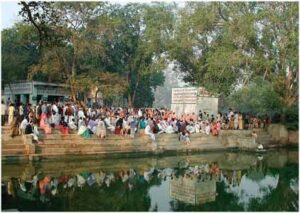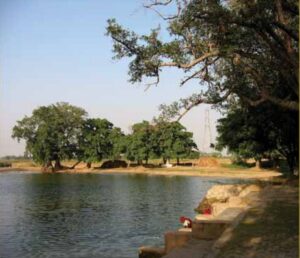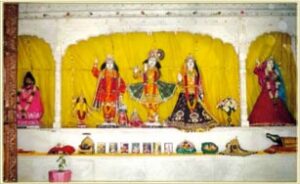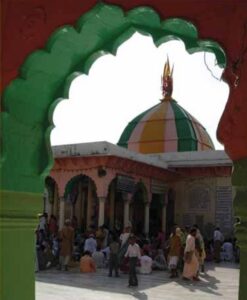Table of Contents
ToggleLocation
This place lies just across the Yamuna from Mathura, approximately two miles north-east of the Mathura-Gokula highway.
Why Called as Lohavana?
Bhakti-ratnākara describes Lohavana as follows:
lohavane kṛṣṇera adbhuta-gocaraṇa
nanapuṣpa sugandhe vyapita ramyasthāna
ethā lohajanghasure badhe bhagavan
lohajanghavana nāma hayata ihāra
“The forest of Lohavana is decorated with all varieties of trees and flowers and is one of the places where Krsna pastures His cows. It is called Lohavana because, while grazing the cows here, Śrī Kṛṣṇa killed Lohajanghasura.”

Krsna, The Boatman of Gopis
At a Yamuna ghața, Kṛṣṇa enjoyed boating-pastimes in the company of the gopis. These pastimes has been beautifully described in Bhakti-ratnākara:
yamuna-nikate yai śrinivase kaya
ei ghate kṛṣṇa naukā-krīḍā ārambhayā
se ati kautuka rãi sakhira sahite
dugdhādi laiya āisena pāra haite
dekhi, se apurva sobha kṛṣṇa mugdha haiyā
eka bhite rahilena jirṇa naukā laiyā
śri-radhika sakhisaha kahe bāre-bāre
pāra kara navika-yaiba sighra pāre
“Lohavana is a charming and delightful place adorned with attractive flowers of all kinds. Nearby, in the virtuous Yamuna, Śrī Krsna performs boating-pastimes with the gopis. Disguised as a boatman, He seats the beautiful young cowherd girls in His boat and takes them out into the middle of the Yamuna’s flowing waters. Then He says, ‘My old dilapidated boat is leaking, and water is rushing in. Throw all your pots of milk and yoghurt overboard; otherwise, it will surely sink.’ The gopis beg and beseech this boatman to quickly take them to the other side of the river.”
This pastime place still lies here today, and concealed within it is Krsna’s boating-pastime with the gopis. One can also have darśana of Krsna-kunda, Lohāsura’s cave and Śrī Gopinatha here.

Durvāsā Asrama
This place lies across the Yamuna one mile north of Visrama-ghața in Mathura. It is Maharși Durvasa’s place of austerities. It was from here that Durvasã crossed the Yamuna on Dvadasi and went to the palace of Ambarīṣa Mahārāja in Mathurā just when the king was due to break his Ekadasi fast. This pastime has been narrated in detail in Srimad Bhagavatam (Ninth Canto, Fourth Chapter). Just near the hermitage of Durvāsā was the asrama of Maharsi Parasara. Śrī Vyasa and other sages and saints would visit Maharsi Parasara there. Close by, on the bank of Yamuna, was the asrama of Dattatreya. The mother of Śri Vyasadeva, Satyavati (also known as Matsyagandha), stayed here with her father, the boatman who had raised her. The island on which Kṛṣṇa-dvaipayana Śrī Vedavyāsa took birth is nearby in the Yamună. At Durvāsā Asrama, the gopis satisfied Maharṣi Durvasa by offering him various kinds of delicious foodstuffs.

Today a large and magnificent temple has been built here that is unique in Vraja. This temple has deities of Maharṣi Durvāsā, Śrī Caitanya Mahaprabhu, Śrī Rādha-Kṛṣṇa and Śrī Yamuna-devi.

Ayore-Grāma
This village lies near Lohavana. During the Muslim rule, this village was named Alipura, and is still known by this name today. When Krsna had killed Dantavakra, He crossed the Yamuna and started for Gokula, to meet with the Vrajavāsīs – His mother, father, sakhās, gopas and gopis. They met Him at this place, crying out with great love, “Ayore, ayore, kanhaiya! – He is coming, Kanhaiya is coming!” Nanda Bābā’s and Yasoda’s meeting with Krsna brimmed with intense affection. This village therefore became known as Ayore.
Bhakti-ratnākara describes this poignant scene:
kṛṣṇa dekhi dhāya gopa anande vihvala
ayore ayore’ bali kare kolāhala
miliya sabare krsna, krsna sabe laiya
nijalaye aila yamunāpāra haiyā
haila paramananda braje ghare-ghare
purvamata saba-saha śrīkṛṣṇa vihare
‘āyore’ baliya gopa yekhāne milila
āyore namete grama thatāya haila
Gorāi (Gaurava, or Gorvāi-gaon, or Gorvāi)
The village of Gorai lies near Ayore-grāma, three miles north- east of Gokula. Today, this village is known as Guru. Nanda Mahārāja resided here for some days along with the other gopas and gopis after they had returned from Kuruksetra. Bhakti-ratnākara states that at the time of Krsna’s pastimes there was a well-known village named Dhana in this very area, where an exceptionally wealthy landlord lived. He had a close, affectionate relationship with Nanda Mahārāja. When Nanda Baba and the gopas and gopis were journeying to Gokula, they arrived at this village. That landlord happily welcomed them with great honour and joy and accommodated them in his village for several days, serving them with much respect. This place has therefore become famous as Gaurava or Gorvai, which is derived from the word gaurava denā, meaning “to give honour”.
Bandi-Anandi
A short distance to the south of Lohavana is the village of Bandi-Anandi. Bandi and Anandi were two heavenly damsels (devis) who would use the excuse of making cow-dung patties here at Śrī Nanda Bābā’s place to get Śri Krsna’s darsana. The kundas of Bandi and Anandi are still present today in memory of these two devis.
Däuji: the place of Baladeva
The village of Dauji is situated ten miles south of Raya and fifteen miles from Mathura. This village is originally called Ridha, but is now known as Dāūji. In the temple here, there is an extremely attractive syāma-complexioned deity of Dāūji. Revati-devi is also present here, but is hidden to the side of Dauji behind the door. The confidential reason why she is somewhat concealed is that Śri Dāūji’s marriage took place while He was residing in Dvaraka and not while He was living in Vraja.

Vajranābha established the deity of Śrī Dāūji. Even though all the famous deities of Vraja left Vraja when the Yavanas (Muslims) invaded, Dauji tricked them and remained here. It is said that this deity was found lying upside down in Kṣirsagara (Sankarṣaṇa-kunda) which is situated on the western side of this temple. Devoted persons took Śri Dauji from the kunda and built this temple, in which they duly seated and worshipped Him. The priests may have put the deity in the kunda in fear of attack by the bigot Aurangzeb.
Dauji’s birth from the womb of Mother Rohini, eight days before the birth of Śrī Kṛṣṇa, took place in Gokula-Mahāvana. His name-giving ceremony, the ceremony held for the first shaving of His head and other purificatory rites (saṁskāras) were performed with those of baby Kṛṣṇa. Dāūji and Krsna would also play and crawl around together.

Ridha or Dauji-gaon was the pasturing ground for Śrī Baladeva’s cows, being a forest area at the time of His manifest pastimes. This place is within Vidrumavana.


